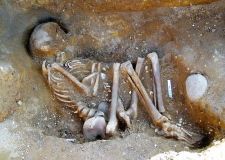
Curled up in her burial pit with her amber beads, an ancient woman's remains show our ancestors farmed a lush Norfolk valley thousands of years earlier than previously believed.
Archaeologists confirmed the significance of the discovery yesterday as work got under way for the summer season at Sedgeford, near Heacham.
Martin Hatton, curator of human remains at the site, was staking out an area of chalk down close to where the find was made last summer, ready for this year's eagerly-awaited dig to begin.
"It was a total surprise to us," he said. "You don't bury people anywhere other than near where they live, so what we can say is that people were farming the land here 4,000 years ago."
Fifteen years ago, a community dig began to uncover the secrets of the village's Saxon graveyard. Since then, each summer has shed more light on the past.
Project director Gary Rossin said the aim of this summer's dig was to explore a D-shaped ditched enclosure on the side of the chalk down overlooking modern-day Sedgeford.
"We've been trying to understand the Anglo-Saxon settlement side of things but over the last two years we've had these curve balls thrown at us - burials where we didn't expect to find burials.
"They're late-Neolithic, although you'll find some archaeologists disagree about that."
As if to prove the point, a man looks up further down the field and shouts: "Bronze Age."
Mr Rossin went on: "We had radio carbon dating done on the one we found in 2009, which said 2450 - 2200BC. That's 4,500 years old.
"We haven't dated the second one but there's no reason to doubt it's the same period."
A body found crouched in a burial pit in 2009 was that of a tall young man. The woman uncovered during last year is believed to be aged from 35 to 45.
Amber beads and a primitive digging tool fashioned from a cow's shoulder blade were found nearby, a few feet under the surface.
Archaeologists wore forensic suits as they painstakingly recovered her remains - to avoid contaminating the skeleton's DNA.
"It's to protect the skeleton from them - not them from the skeleton," said Mr Hatton.
SHARP - the Sedgeford Historical and Archaeological Research Project, which runs the dig - hopes to obtain grants to cover the £1,500 needed to carry out carbion dating and tests with radioactive isotopes needed to date the skeleton and reveal the woman's origins.
The 2009 skeleton pre-dates the building of Seahenge, at nearby Holme-next-the-Sea, by several generations.
Southampton University student Cath Walker, who is researching flints found at Sedgeford for her PhD, said the primitive tools revealed yet more about the human history of the site.
"We've got hunter-gatherer communities moving through the landscape following their food sources," she said. "This is a new chapter, pushing the history of the site back further."
Evidence of a food source first brought over by the Romans is everywhere. Spoil from previous digs is pock-marked with rabbit holes.
But while bunnies went unhugged yesterday, many were wearing bunny hugger T-shirts - inspired by the row that erupted last week, after Fenland council leader Alan Melton said planning rules requiring archaeological surveys to be carried out on building sites should be relaxed to encourage development.
Up to 70 people will be taking part in this year's dig, which runs until August 12. The site is open to the public from 10am - 4pm daily, except on Saturdays. Admission is free.
There are also guided tours each Friday (3pm), lectures in the village church on Tuesday nights (7pm) and courseson everything from basic archaeology to Anglo Saxon cooking.
This year, people are also being offered the chance to join the dig for the day as part of the BBC's Hands On History program.
Places are free but must be booked in advance. For more information, follow the links above.



Reader Comments
to our Newsletter